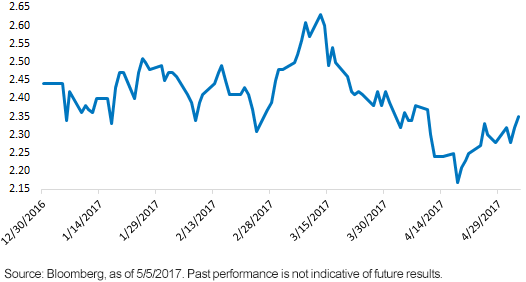Fixed Income Strategy: Staying on Course


When examining the appropriate course for fixed income strategies thus far in 2017, we are already about halfway through Q2 and appear to be staying on course. What exactly is “staying on course,” you might ask? The overall premise for fixed income investing has essentially been playing out according to our base case: blending a strategic core approach with a complementary solution for the potential of higher rates later in the year.
The graph below clearly illustrates that the U.S. Treasury (UST) 10-Year yield has been exhibiting a bit of a sawtooth pattern since the end of last year, but overall it seems to have found a trading range between roughly 2.15% and 2.65%. Interestingly enough, even with all that back-and-forth movement, as of this writing, the UST 10-Year yield stood at 2.35%, or only 9 basis points (bps) below the year-end 2016 reading of 2.44%. However, as we have seen with last week’s FOMC meeting and the April Employment Situation Summary, the prospects for a new and elevated trading range in the months ahead remain alive and well.
U.S. 10–Year Treasury Yield

Let’s take a look at the May Federal Reserve (Fed) policy gathering first. Heading into the convocation, there was some conjecture that the soft Q1 real GDP performance of only +0.7% could give the voting members some pause regarding their tightening plans for 2017. Based on the policy statement, the Fed appears to be on track with the guidance it has provided thus far: two more rate hikes this year, followed by the possibility of beginning a balance sheet normalization process either later this year or early in 2018. In fact, the Fed viewed the slowing in Q1 growth as “likely to be transitory,” Fed-speak for temporary with a return to its own economic outlook in short order.
As far as the April jobs report is concerned, the underlying tenor of the data would tend to support that “transitory” assessment. The unemployment rate dropped 0.1 percentage points to 4.4% (its lowest level since 2007), while nonfarm payrolls grew by a stronger-than-expected +211,000. Average hourly earnings have been stuck in a year-over-year band of +2.5% to +2.9% (April came in at +2.5%), but other wage measures, such as the Employment Cost Index, have shown continued improvement. In the post-jobs-data market, Fed Funds Futures now reveal an implied probability of 100% for a June rate hike as compared to only 50% as recently as two weeks ago.
Conclusion
Fixed income investors should not expect the path to higher rates to necessarily be a one-way street; the more likely scenario is a sawtooth pattern, with the end result being a new and elevated trading range for the UST 10-Year yield, accompanied by a higher Fed Funds target range as well. Back to the point I made in my opening paragraph. Against this backdrop, investors may wish to pursue a fixed income strategy that blends a core approach, utilizing the WisdomTree Barclays Yield Enhanced U.S. Aggregate Bond Fund (AGGY), with a complementary rising rate solution such as the WisdomTree Interest Rate Hedged High Yield Bond Fund (HYZD).
Unless otherwise noted, source is Bloomberg as of 5/5/2017.
Important Risks Related to this Article
There are risks associated with investing, including possible loss of principal. Fixed income investments are subject to interest rate risk; their value will normally decline as interest rates rise. Fixed income investments are also subject to credit risk, the risk that the issuer of a bond will fail to pay interest and principal in a timely manner or that negative perceptions of the issuer’s ability to make such payments will cause the price of that bond to decline. Investing in mortgage- and asset-backed securities involves interest rate, credit, valuation, extension and liquidity risks and the risk that payments on the underlying assets are delayed, prepaid, subordinated or defaulted on.
High-yield or “junk” bonds have lower credit ratings and involve a greater risk to principal. The Fund seeks to mitigate interest rate risk by taking short positions in U.S. Treasuries, but there is no guarantee this will be achieved. Derivative investments can be volatile, and these investments may be less liquid than other securities, and more sensitive to the effects of varied economic conditions.
The Funds may engage in “short sale” transactions where losses may be exaggerated, potentially losing more money than the actual cost of the investment, and the third party to the short sale may fail to honor its contract terms, causing a loss to the Fund. While the Funds attempt to limit credit and counterparty exposure, the value of an investment in the Funds may change quickly and without warning in response to issuer or counterparty defaults and changes in the credit ratings of the Fund’s portfolio investments. Due to the investment strategy of the Funds, they may make higher capital gain distributions than other ETFs. Please read each Fund’s prospectus for specific details regarding each Fund’s risk profile.


